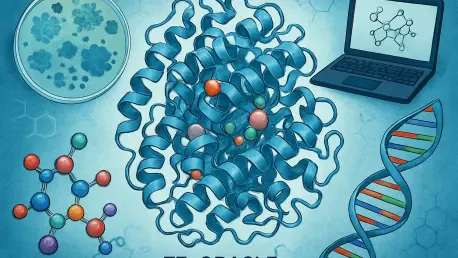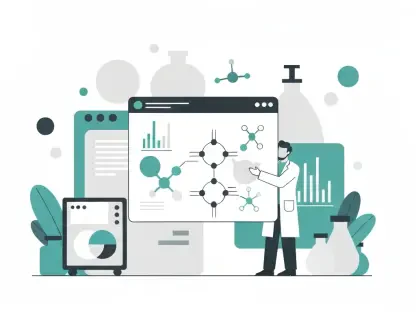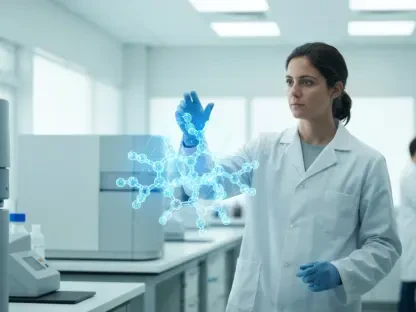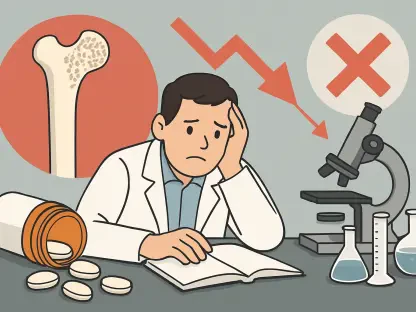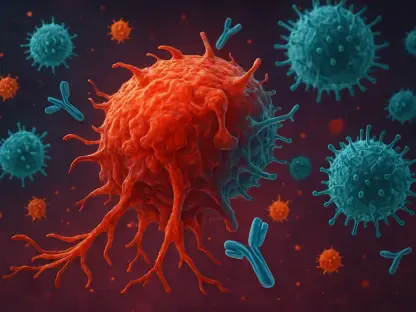What if the key to defeating devastating diseases like cancer or antibiotic-resistant infections could be unlocked in mere days instead of months or years, transforming the landscape of medical research? This isn’t a distant dream but a tangible reality with a groundbreaking tool developed by scientists at Scripps Research. Known as T7-ORACLE, this synthetic biology platform is transforming protein engineering by accelerating the design of life-saving proteins with unprecedented speed and precision. This feature dives into the heart of this innovation, exploring how it’s poised to reshape medicine and biotechnology for a healthier tomorrow.
Why Protein Engineering Is a Global Priority
Protein engineering stands as a cornerstone of modern science, underpinning breakthroughs in everything from targeted drug therapies to sustainable industrial processes. Proteins, the molecular workhorses of life, can be tailored to perform specific tasks, such as attacking cancer cells or breaking down pollutants. However, traditional methods to modify these molecules are often painstakingly slow, hindering the ability to respond swiftly to pressing health crises like emerging drug-resistant bacteria or rare genetic disorders.
The stakes have never been higher. With personalized medicine on the rise and global health threats evolving rapidly, the demand for faster, more effective protein solutions is urgent. T7-ORACLE steps into this gap as a game-changing solution, offering a way to engineer proteins at a pace that matches the speed of today’s challenges. Its potential to impact millions of lives makes this technology a critical focus for researchers and innovators alike.
Decoding the T7-ORACLE Innovation
At its core, T7-ORACLE reimagines directed evolution, a technique that mimics natural selection to refine proteins through repeated mutation and testing. Unlike older methods that require weeks per cycle, this platform enables continuous evolution within living E. coli cells, leveraging a modified T7 bacteriophage DNA polymerase. This setup triggers hypermutation in target genes on plasmids at rates up to 100,000 times higher than nature, all while leaving the host cell’s DNA untouched.
The speed is staggering. With E. coli dividing every 20 minutes, T7-ORACLE evolves proteins with each cycle of cell growth, slashing timelines from months to days. Its versatility shines through in applications ranging from crafting antibodies for medical treatments to designing enzymes for eco-friendly manufacturing. This adaptability positions the platform as a universal tool, ready to tackle diverse scientific puzzles with remarkable efficiency.
A Testament to Rapid Results
Proof of T7-ORACLE’s power came through a striking experiment with the TEM-1 β-lactamase gene, tied to antibiotic resistance. In under a week, scientists evolved variants of this gene to withstand antibiotic concentrations 5,000 times higher than the original could handle. This rapid achievement not only highlighted the system’s precision but also replicated real-world resistance mutations seen in clinical settings.
Such results underscore a broader potential. Beyond mimicking natural outcomes, the platform can generate novel protein functions that surpass what evolution alone might achieve. This capability opens doors to solutions for complex diseases and industrial needs, demonstrating that T7-ORACLE isn’t just keeping pace with nature—it’s outrunning it in the race for innovation.
Insights from the Pioneers
Those behind T7-ORACLE emphasize its groundbreaking accessibility and vision. Christian Diercks, co-senior author and assistant professor at Scripps Research, highlights its ease of use: “Labs already working with E. coli can adopt this system seamlessly—evolution unfolds with each cell division, not weeks of manual labor.” This simplicity ensures that even smaller research facilities can harness cutting-edge technology without specialized equipment.
Pete Schultz, President and CEO of Scripps Research, looks toward a grander horizon: “By blending rational design with continuous evolution, this platform uncovers functional molecules faster than ever before.” His perspective points to a future where biological systems can be reprogrammed independently of a cell’s natural processes, amplifying control over therapeutic and scientific advancements. These voices from the forefront reveal a shared optimism about the transformative impact awaiting biotechnology.
Empowering Labs with Practical Solutions
For researchers eager to tap into T7-ORACLE, the process is straightforward and actionable. Start by selecting a protein target—be it an antibody for disease treatment or an enzyme for industrial use—and integrate its gene into a compatible plasmid. From there, standard E. coli cultures serve as the host, initiating continuous evolution with minimal setup adjustments.
The next step involves applying selective pressures, such as escalating drug doses, to refine desired traits in days rather than months. Once optimized, these evolved proteins can be scaled for real-world applications, whether in developing cancer-targeting proteases or enhancing sustainability through better enzymes. This user-friendly framework democratizes access to high-speed protein design, empowering labs of varying resources to drive meaningful progress.
Looking Ahead to New Horizons
Reflecting on the journey, T7-ORACLE carved a path that redefined protein engineering with its blend of speed, precision, and accessibility. Its ability to evolve solutions in record time stood as a beacon of hope for addressing some of humanity’s toughest medical and environmental challenges. The success with antibiotic resistance genes marked just the beginning of what this platform achieved.
Moving forward, the scientific community can build on this momentum by exploring uncharted applications, from synthetic nucleic acids to tailored human enzymes for therapy. Collaborative efforts between labs worldwide could accelerate the translation of these innovations into clinical and industrial settings. As the next chapter unfolds, prioritizing investment in such technologies and fostering interdisciplinary partnerships will be key to unlocking the full potential of engineered proteins for a better, healthier world.
